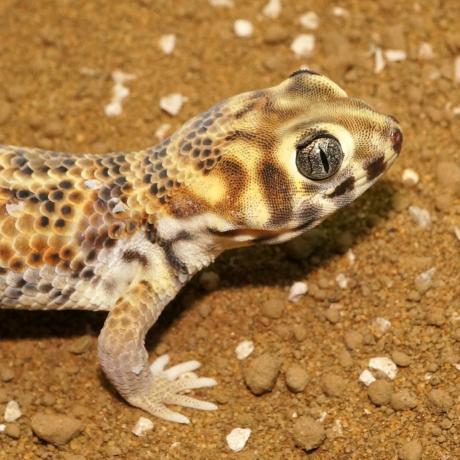

The Frog Eyed Gecko or Wonder Gecko as it is also referred to is a medium sized gecko that inhabits deserts of Central Asia.
| Origin | Central Asia |
|---|---|
| Environment | Desert and arid land |
| Adult Size | Up to 20cm |
| Suitability | Novice keeper |
| Lifespan | Up to 20 years |
| Temperament | Docile |
The Frog Eyed Gecko is a strange but lovely looking animal, quite unique in appearance. One of the first things you notice are the Geckos large eyes, this is where the common name comes from. The head is large and broad, with a short snout.
The next distinctive feature is the geckos fish like body scales. These scales are designed to help absorb moisture within the harsh environment they live in and to help move in the sand when burrowing. They are soft to the touch, however, if handled, these can rip and tear away with ease, therefore handling should always be kept to a minimum. They can produce a hissing/rattling sound by moving their tail side to side, this is normally only heard in courtship, territorial behaviour or as a defensive.
The limbs are yellow to orange in appearance, long and strong, holding themselves clear from the ground when they stand or move. The toes have a fringe of serrated scales that help them move across loose sand. The body colour is yellowish with darker striped running the length of the back. If you look at each body and tail scale, you will see these have at least two shades of colour on them. The head has darker spotting with a near black mark just above the front shoulders. The sides are pale in colour and the underside is immaculate white.
Frog Eyed Geckos are nocturnal, terrestrial (ground dwelling) and a burrowing species. They reach an adult size of 13-20cm (5-8 inches) and can be vocal if angry or being territorial.
They inhabit desert and arid lands from Southern Asia to Western China, along with many Mideastern countries onto Pakistan. They are excellent at digging and making burrows; they dig through the dry surface sand to reach moister sands below.
As with most species of lizards, it is always advised to keep only one male per enclosure as they become territorial and can inflict injury on one another. Keeping a sexed pair or trio is possible providing enough space and areas to hide.
A single Frog Eyed Gecko can be kept in a minimum sized enclosure of 2ft, a pair or trio should be provided at least 3ft, however, more space you can provide, the better. Wooden enclosures help hold in heat better compared to glass, however, if using the correct heating this can be achieved in either. They require more floor space than height, they aren’t great climbers and would prefer to dig in the sand.
Heating the enclosure can be achieved using a ceramic heater or a basking bulb, these should always be connected to the correct thermostat. The ambient air temperature should range from 29-34C (84-93F) with a basking area of 35-38C (95-100F). Allow air temperature to drop down 20-25C (68-77F) during the night. If you wish to breed this species, you should gradually reduce the temperatures down to 10-16C (50-61F) for a 2-3 month period before slowly increasing back to warmer temperatures.
Due to this species being nocturnal, UVB lighting is not essential, however, we would recommend using a low percentage to simulate day and night. This can be in the form of a UVB stripe light or a smaller UVB compact bulb of 2% or 5%. Provide day light in summer for 10-12hrs, this can be reduced in winter to 8hrs.
The Frog Eyed Gecko will naturally prefer to burrow if given the chance, therefore providing a substrate that allows this is beneficial for the animal. Ideally, you need to have a dry top layer of sand and below this should be damp. This can be difficult to maintain in a vivarium, therefore, we would recommend providing a few humidity hides within the enclosure. The use of artificial plants or live (if in a bioactive tank) along with rocks and caves should give the geckos places to hide and explore.
A small water dish should be provided and replaced every few days or if soiled. Feeding Frog Eyed Geckos is easy as they aren’t fussy eaters; most live insects will be eaten including crickets, locusts, waxworms and mealworms. In the wild, their main diet consists of beetles, therefore, allow some of the mealworms to turn to beetles. Ensure the livefood is dusted with calcium on every feed apart from one day where a good vitamin and mineral supplement should be used instead. Gut loading the livefood is also recommended to pass on nutrition to your Geckos.